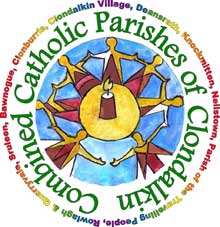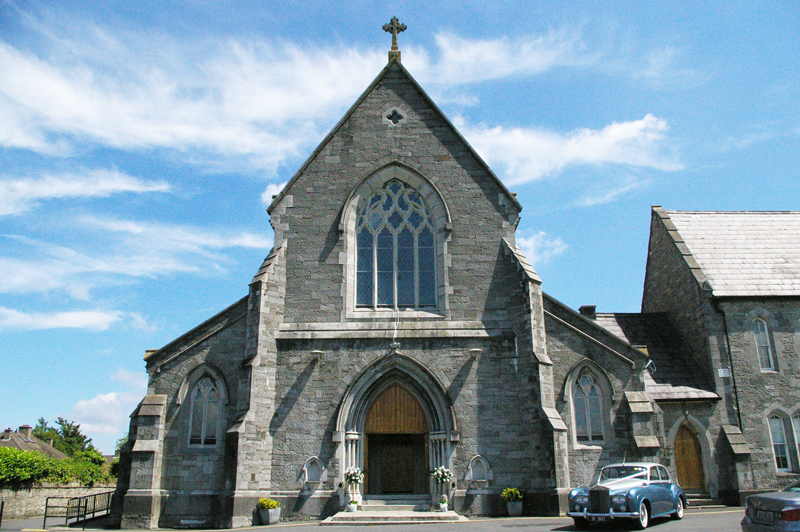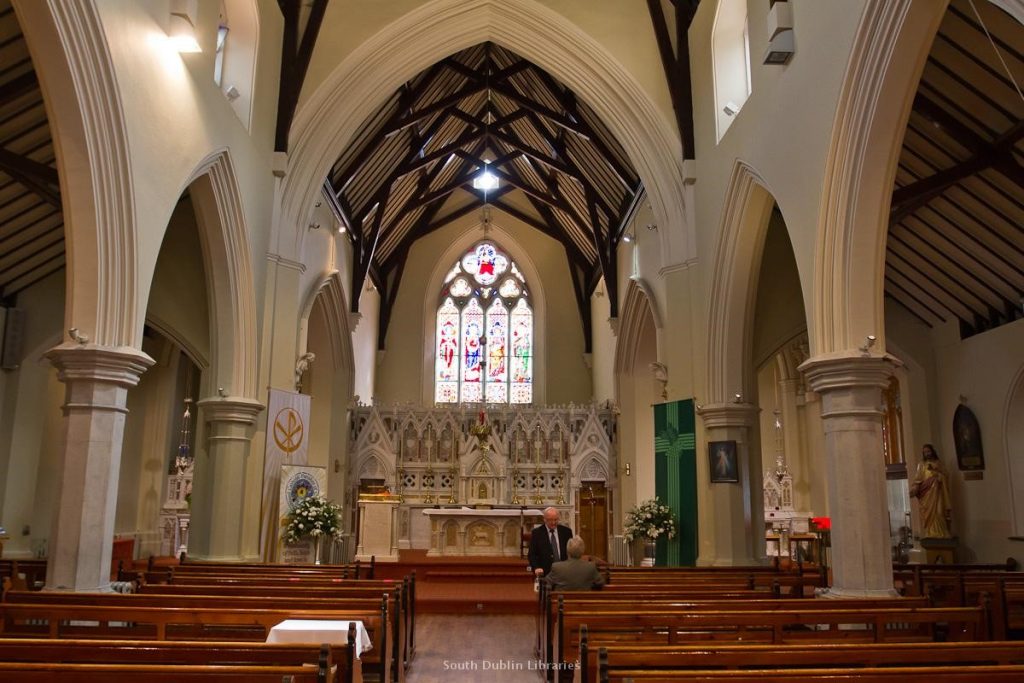History of the Church
The Church of the Immaculate Conception & St. Killian, Clondalkin
The site for the Church and adjoining Convent was donated by the Caldbeck Family of Moyle Park, Clondalkin. The foundation stone was laid in 1857 and the completed Church was dedicated in 1862. The Church was dedicated to St. Killian, a local saint and also to the Immaculate Conception (the doctrine of the Immaculate Conception having been promulgated in 1858). The Church was designed by William Caldbeck, a noted architect of the day, and is built in the Gothic revival style which had recently been introduced to Ireland by the famous English architect, W. A Pugin. The Church and Convent are among the best examples of Gothic revival buildings in Dublin. The stone used is calp limestone quarried at Monastery Road, Clondalkin. The stained-glass windows are by the famous artist, William Early, who died during the commission. The Church has now been in continuous use for almost a hundred and forty years. It is a loved landmark and one of the focal points of the Clondalkin community. It has been lovingly maintained over the years and will continue to be in the future. From monastic times down to the reformation Clondalkin church was situated in the area now occupied by St. John’s Church. The ruins of the chancel of the medieval church were left to one side of St John’s when it was opened in 1799. Subsequently, up to the 1860s, the Catholic parish church was in the chapel field of the Monastery Road. A local lady with a keen interest in the education of local girls who, died in 1844, left £2,000 for the erection of a convent and school. The then parish priest, Fr. Moore, took advantage of this request to purchase a site for the erection of a convent, which was completed in 1857. In that year the foundation stone of a new gothic style church to adjoin the convent was laid. The new church was designed by W.F. Caldbeck, an engineer and architect of Harcourt St. and built by Michael Kennedy of Malborough St. at a cost of £5,000 (£300,000 approximately in present day money). The new church was dedicated on the 11th of August, 1862 under the title of “The Immaculate Conception” by the then archbishop of Dublin the most reverend Dr. Cullen. A further small addition to the church, to the rear of the vestry, was made in 1987. The present R.C. Church dates from 1862 when it was consecrated. The old R.C. parish of Clondalkin was constituted in 1615 and contained the following areas: Clondalkin, Lucan, Kilbride, Kilmactalway, Esker, Drimnagh, Addrig, Ballyfermot, Palmerstown and Kilmahuddrick. Around 1844 Fr. Moore, then curate of the parish of Clondalkin, Lucan and Palmerstown bought 20 acres of land from Mr. Hegarty for £300 and a yearly rent of £25. This money came from the legacy of Miss Anne Caldbeck. From the diary of Luke Cullen – Bro Elias – we learn that on Sunday 8th March 1857 Fr. Moore, by then Parish Priest, held a parochial meeting in the Chapel House. He proposed the erection of a new church. It is recorded that his suggestion was responded to “in a manner unprecedented in the Annals of Chapel building in Ireland”. Certainly a large sum of money was pledged with many parishioners subscribing £50 to £100 each. The foundation stone was laid on Sunday 5th July 1857 by His Grace the Most Rev Paul Cullen, Archbishop of Dublin. In a container placed under the stone were coins of Pope Pius IX and of the reigning sovereign, Queen Victoria, along with an inscribed parchment. The church was designed by F.W. Caldbeck in the Gothic style. It was solemnly blessed by His Grace Dr. Cullen on Sunday 10th August 1862 when Pontifical High Mass was celebrated by the Bishop of Bombay Rt. Rev Dr. Whelan. The Belfry was raised in 1871 and according to the Catholic Register of 1881 the High Altar was consecrated on 8th September 1880. The celebrant was Right Rev Christopher Reynolds, Bishop of Adelaide Australia who had been educated at Mount St. Joseph’s College. In 1891 an ornamental archway was erected at the New Road entrance. This was to commemorate the Golden Jubilee of Fr. John Moore and stands today as a fitting tribute to his fifty-three years of service to the parish.
The “Church of the immaculate Conception’
Joe Williams, May 1996.
Brigid’s Well
In the Ordnance Survey Names Book there is the following entry: ‘Brideswell Commons – an isolated piece of land in the townland of Clondalkin, the property of William Caldbeck Esq., and rented to Mr. Ormsby; it has only two pasture fields divided by a lane, a beautiful spring on the side of the lane is nicely built over and on a marble slab is written ‘St. Bridget’s Well’. ‘Legend has it that St. Brigid came to the site of the monastery at Cluain and baptised pagans at the well on Boot Road. The structure around dates from 1761. The original railings were donated by the Paper Mills in the 1940’s and the statue was given by Mary O’Toole. About this time there were processions to the well on 1st. February, the feast day of St. Brigid. There is a tradition that there was a burial place for unbaptised infants adjoining the well. This was due to a lease of lands in this area from Mr. Caldbeck dated 1843 having an item showing “Burial Ground 4 Perches”. The well is believed to have curative powers. A piece of rag dipped in the water and used to wipe the face, particularly of young girls, was said to cure eye complaints. After use the rag would be hung on the adjoining tree. The well was refurbished by South Dublin County Council in 1995.
Glory in Glass
As one enters the Parish Church your attention is immediately drawn to the stained glass over the High Altar. This beautiful window was designed by Thomas Early and was installed in 1857. Rather than depict the more usual crucifixion scene, Mr. Early decided to honour the patron Saints of the Parish of Clondalkin. Starting from the left we see St. Laurence O’Toole, dressed in his bishop robes and vestments ready to say Mass. He also has on his pallium, the white cloth over his shoulders with the stripe hanging down in front. The pallium may only be worn by an Archbishop when in his own diocese. There is one minor error, while all the Archbishop’s fingers are visible, his ring is not shown. Next we come to Mary, the Mother of God. She is shown with ‘the moon under her feet’ and wearing the ‘crown of twelve stars’. This is the traditional way of depicting Mary as the Immaculate Conception. The third section shows St. Joseph holding in his right hand a rod with lilies growing from it. This lily rod indicates that God entrusts many matters to Joseph as protector. Finally there is St. Patrick, shown a bishop with his mitre and crosier. He is wearing a cope, the outer vestment worn at ceremonies other than mass. In his right hand he holds a shamrock and under his feet is a dying snake. Thomas Early committed suicide in 1893 while staying with Rev. Baxter P.P. Clondalkin, a memorial window to him was placed in the church.
The stain glass window above the High Alter
From an article in the Clondalkin People (Nov. 1988) by Fr. Tom O’Loughlin.
Luke Cullen – Brother Elias
The Monk of Clondalkin. One of the most interesting brothers to teach at Mount St. Joseph was Brother Elias, Luke Cullen. He joined at Clondalkin when he was 45 years old. Born in Little Bray, Cabinteely in 1793, he spent most of his working life at sea. However he also found time to travel throughout Wicklow and Wexford collecting the memoirs of the survivors of the 1798 Rebellion, a task he seems to have continued after he joined the Carmelite community. Although without book-learning he was put teaching in the Free School where he transcribed his collected material on to whatever scraps of paper he could find; roll books and on the back of letters. Writing to Dr. R. Madden on 13th October, 1843 he describes his working conditions as “I am obliged to write in school hours, subject to great interruption and the clamour of 140 boys taking advantage of me when occupied”. In spite of these conditions he left behind a marvellous collection of manuscripts which as well as recording the events of 1798, include historic notes on Clondalkin and details of the lives of Anne Devlin and Michael Dwyer. His writings, which are held in Trinity Library and the National Archives, have been used as source material by many historians. Luke Cullen died on the 6th January 1859 and he was buried in the monastery cemetery.
Joe Williams July 1996
Article written by : Stephen O’shea
This entry was posted in History. Bookmark the permalink.

